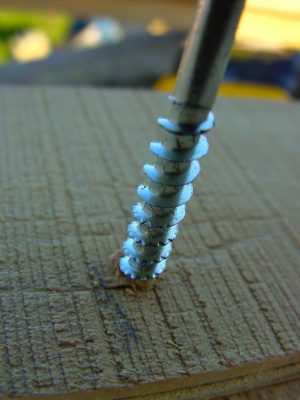At 45º from horizontal, this roof is too steep to work on without some kind of support. Roof jacks offer the best option for staying safe and storing your tools while putting up roof sheathing now, and roof insulation, shingles and skylight later. We also use safety harnesses for tying ourselves off with ropes thrown over the roof ridge and tied to the base of a stout tree on the other side. Be sure to get training from a qualified expert on how to install and use roof jacks and safety harnesses before you proceed. It’s not complicated, but you can’t beat hands-on training.
Screws Sometimes Better Than Nails
 There are three reasons why screws make more sense than nails for some applications. Screws hold better than nails, they don’t required the disruption of hammer blows to drive them, and today’s cordless impact drivers make it especially fast and easy to drive screws. The best general-purpose wood screws for exterior use are hot-dipped galvanized and have a wavy thread pattern. This helps the screw cut its own threads into the wood, reducing the chance of splitting and making the screws easier to drive.
There are three reasons why screws make more sense than nails for some applications. Screws hold better than nails, they don’t required the disruption of hammer blows to drive them, and today’s cordless impact drivers make it especially fast and easy to drive screws. The best general-purpose wood screws for exterior use are hot-dipped galvanized and have a wavy thread pattern. This helps the screw cut its own threads into the wood, reducing the chance of splitting and making the screws easier to drive.
Adding Fascia Boards
Complete the roof frame by installing the fascia boards on the triangular gable ends of the roof, and along the eaves. The video here shows the 1 1/2”-thick, 10”-wide boards we used for this job. Why so wide? Three reasons. First, the fascia boards need to cover the rafters while also going up high enough to cap the ends of the 2 1/2”-thick insulating panels that go on roof later. Also, it’s good practice to have the fascia boards extend down lower than the rafters, to act as a drip edge for shedding water after the aluminum fascia goes on over the wood. And finally, the width of fascia boards offers the best visual appearance. Anything thinner just looks too spindly.
VIDEO: Installing Fascia Boards
Finish up by cutting openings for your openable skylights. (I hope you’ll be installing them). Then apply roll roofing, ice and water shield or some kind of waterproof membrane on top of the roof boards and right over the skylight openings. This makes your cabin roof weatherproof, while also acting as a vapour barrier to prevent frost from forming underneath and between the insulation sheets that sit on top of the roof. Think of this membrane like a thick vapour barrier on the warm side of the roof structure. Extruded polystyrene foam does act as it’s own vapour barrier, but you need to be absolutely sure that condensation won’t occur between the roof sheathing and the underside of the foam if warm, indoor air makes its way into cooler zones. Some kind of membrane with low permeability is cheap insurance to protect against this danger.
Milestone #5
Your rafters are up and covered in roof boards and a waterproof membrane. Loft floor boards are in place.